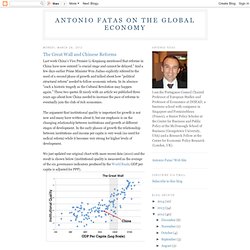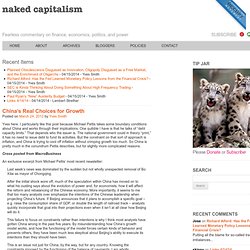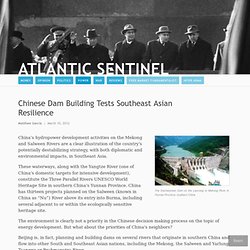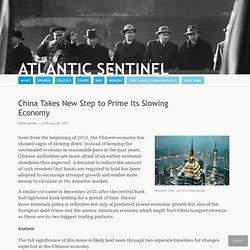

Comparing China Versus the United States on Misallocated Investment. The Great Wall and Chinese Reforms. Last week China's Vice Premier Li Kequiang mentioned that reforms in China have now entered "a crucial stage and cannot be delayed.

" And a few days earlier Prime Minister Wen Jiabao explicitly referred to the need of a second phase of growth and talked about how "political structural reform" needed to follow economic reform. In its absence "such a historic tragedy as the Cultural Revolution may happen again. " These two quotes fit nicely with an article we published three years ago about how China needed to increase the pace of reforms to eventually join the club of rich economies. The argument that institutional quality is important for growth is not new and many have written about it, but our emphasis is on the changing relationship between institutions and growth at different stages of development. Corporations and standards around the world. The ongoing debate about Apple’s supply chain in China has me wanting to put down a couple of quick thoughts on corporations and whether they should, to put it broadly, promote laws and standards around the world.

This isn’t an attempted knockout punch to any position, and while I am often a critic of regulations, and will be here in some places, this is just as much of a rebuttal to Milton Friedman’s argument that the only social obligation of business is to maximize shareholder profits. In many developing nations, the legal system functions poorly, and international corporations are often more capable of enforcing efficient laws throughout their supply chain than anyone else. This can be, to some extent, due to pressure from U.S and other western customers to “behave ethically”. Another benefit of corporation enforced standards, which applies to environmental, labor, and other kinds, is that corporations are more likely to find the least cost ways to comply. Maybe, I suppose. China’s Real Choices for Growth. Yves here.

I particularly like this post because Michael Pettis takes some boundary conditions about China and works through their implications. One quibble I have is that he talks of “debt capacity limits.” That depends who the issuer is. The national government could in theory “print,” it has no need to issue debt to fund its activities. Satyajit Das: “All Feasts Must Come to an End” – Fake Goods, Fake Growth? (Part 3) By Satyajit Das, derivatives expert and the author of Extreme Money: The Masters of the Universe and the Cult of Risk Traders, Guns & Money: Knowns and Unknowns in the Dazzling World of Derivatives – Revised Edition (2006 and 2010) Part I; Part II.

A significant part of China’s growth has been an illusion. Since 2008, China’s headline growth of 8-10% has been driven by new lending averaging around 30-40% of GDP. Given that (up to) 20-25% of these loans may prove to be non-performing, amounting to losses of 6-10% of GDP. If these losses are deducted, Chinese growth is much lower. The China economic debate is focused on the alternatives of a soft or hard landing. The case for the soft landing assumes that the investment and property bubbles are less serious than thought. Growth comes down gradually, without causing social and political disruptions. China government debt at US$2.78 trillion as China Moves to Restructure and Manage the Debt. Chinese Dam Building Tests Southeast Asian Resilience. The Dachaoshan Dam on the Lancang or Mekong River in Yunnan Province, southern China China’s hydropower development activities on the Mekong and Salween Rivers are a clear illustration of the country’s potentially destabilizing strategy, with both diplomatic and environmental impacts, in Southeast Asia.

These waterways, along with the Yangtze River (one of China’s domestic targets for intensive development), constitute the Three Parallel Rivers UNESCO World Heritage Site in southern China’s Yunnan Province. China has thirteen projects planned on the Salween (known in China as “Nu”) River above its entry into Burma, including several adjacent to or within the ecologically sensitive heritage site.
The environment is clearly not a priority in the Chinese decision making process on the topic of energy development. But what about the priorities of China’s neighbors? Downstream riparian nations include Bangladesh, Burma, Cambodia, India, Laos, Thailand and Vietnam. China hotel shows nation's building boom may move at warp speed. Reporting from Changsha, China — In early December, Liu Zhangning was tending her cabbage patch when she saw a tall yellow construction crane in the distance.

At night, the work lights made it seem like day. Fifteen days later, a 30-story hotel towered over her village on the outskirts of the city like a glass and steel obelisk. "I couldn't really believe it," Liu said. "They built that thing in under a month. " China Takes New Step to Prime Its Slowing Economy. Shanghai, China, July 2010 (Andy Brandl) Seen from the beginning of 2012, the Chinese economy has showed signs of slowing down.

Instead of keeping the overheated economy in reasonable pace in the past years, Chinese authorities are more afraid of an earlier economic slowdown than expected. A decision to reduce the amount of cash reserves that banks are required to hold has been adopted to encourage stronger growth and enable more money to circulate in the domestic market. A similar cut came in December 2011 after the central bank had tightened bank lending for a period of time. China embarks on latest reform blitz - Craig Stephen's This Week in China. By Craig Stephen HONG KONG (MarketWatch) — According to news last week, mainland Chinese authorities are readying for a reform blitz, from currency convertibility to overhauling state-owned enterprises (SOEs), and even changes to the “hukou” registration system.

The instinctive reaction is to dismiss this as bluster, but could we be underestimating policy risk as China begins its transition to a new government this autumn? Time and again, government or related think tanks highlight problems in China’s economy, along with an impressive-looking package of policy reform. But invariably these timetables get pushed out to some indeterminable date, as there is no political will to push through change. Still, difficult or painful decisions rarely take place when times are good. Air pollution choking Hong Kong Pressure is mounting on the government to remove all 'dirty' vehicles from Hong Kong roads. Emerging Markets and the Global Middle Class. Most analysts agree that the greatest opportunities for companies looking to grow significantly will be found in emerging markets.
The reason is simple: markets in developed countries are generally saturated and companies can only grow there at the expense of other companies -- a zero sum game. Consumers in emerging markets are also more optimistic about their economies than consumers in developed countries. At least they were a couple of years ago. ["Developing nations’ confidence points to two-speed recovery," by Daniel Pimlott, Financial Times, 11 August 2010] According to 2010 polls, 85 per cent Indian consumers saw "their country’s economic situation as good, while 77 per cent of people in China and 65 per cent in Brazil [were] also optimistic. " I suspect those number might have fallen over the past couple of years, but not precipitously. How Neoliberalism Changed Economic Development: The Examples of India and China. China Tells Banks to Roll Over Loans - Asia Business News. China has instructed its banks to embark on a mammoth roll-over of loans to local governments, delaying the country’s reckoning with debts that have clouded its economic prospects.

China’s stimulus response to the global financial crisis saddled its provinces and cities with 10.7 trillion yuan ($1.7 trillion) in debts — about a quarter of the country’s output — and more than half those loans are scheduled to come due over the next three years. Since the principal on many of the loans is not repayable, banks have started extending maturities for local governments to avoid a wave of defaults, bankers and analysts familiar with the matter told the Financial Times.
One person briefed on the plan said in some cases the maturities would be extended by as much as four years. “An appropriate maturity extension is in the banks’ interest,” said Fan Jianping, chief economist of the State Information Centre, a think-tank within the government’s powerful planning agency.
Government & Governance. Food & Water. Polution. Finance. Society. US Relations. Cities & Urban Society.